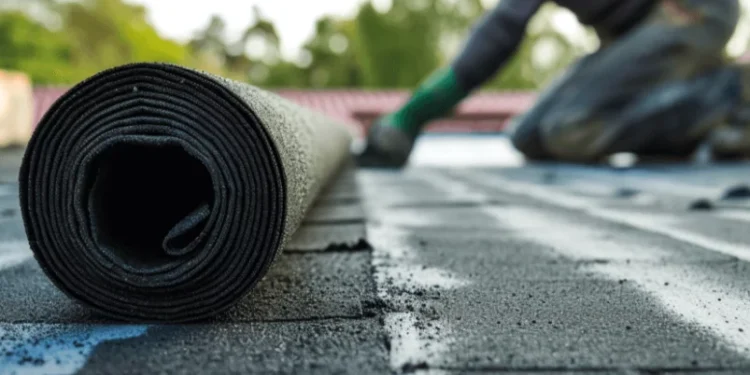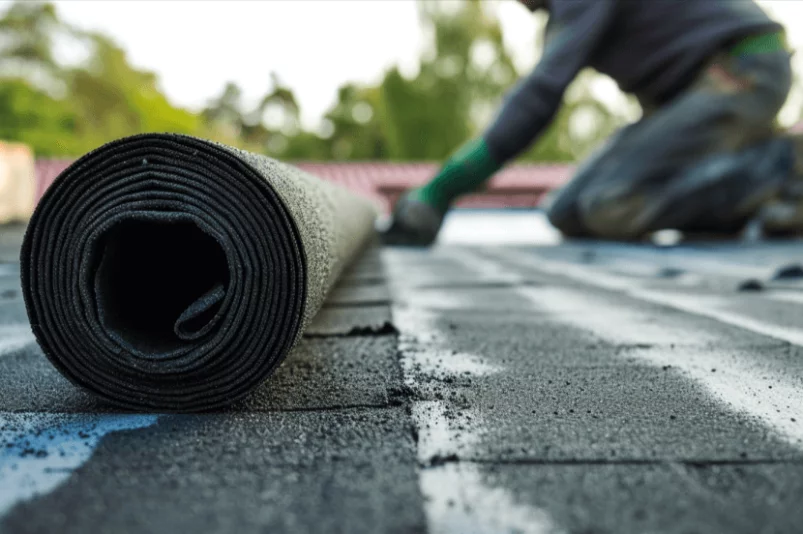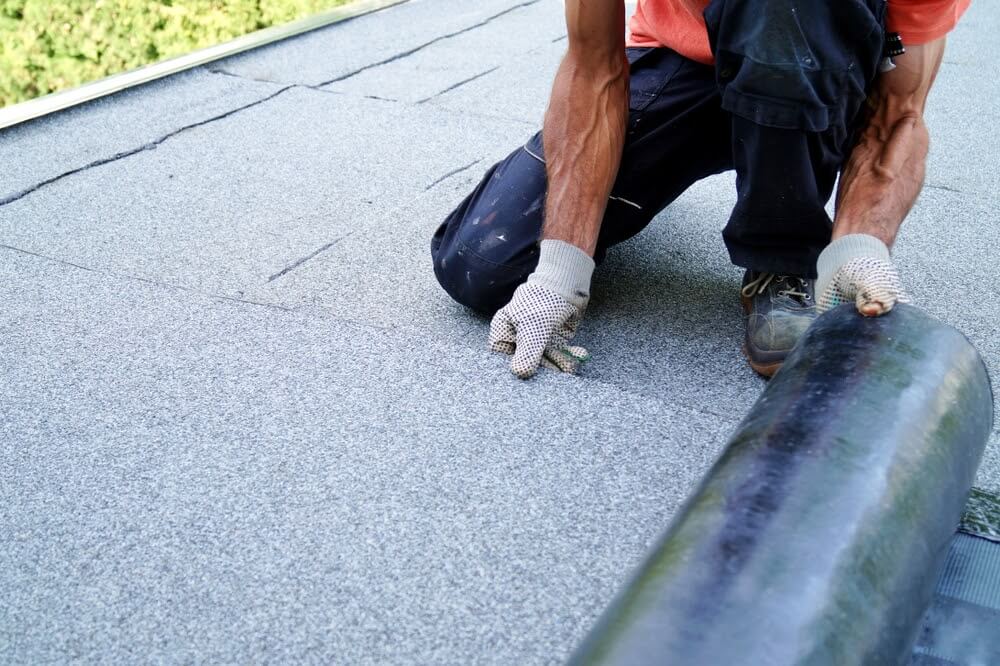Roll Roofing

Roll roofing ranks among the most affordable options you can find today. Materials cost between $1.50 to $3.00 per square foot. Budget-conscious homeowners often choose this option to cover their low-slope roofs.
Roll roofing costs less by a lot compared to shingles, metal, or tiles. The upfront savings look great, but you should think about its lifespan. These roofs usually last 5 to 15 years, which falls short compared to other materials. This material works best on low-slope roofs, sheds, garages, and workshops. Many homeowners tackle roll roofing projects themselves because the installation process feels straightforward compared to regular shingles. The choice between these options comes down to long-term costs. Let’s explore the financial aspects of each option in this piece.

Table of Contents
What is Roll Roofing and How Does It Compare to Shingles?
Homeowners need to know how roll roofing and shingles are different to make smart choices about their roofing investments. These common roofing materials share similar components but serve different purposes.
Basic definition of roll roofing
Roll roofing has large sheets made from asphalt-based materials that come in rolls 36 inches wide and 33-36 feet long. Each roll covers about 100 square feet. People often call it mineral-surfaced roofing (MSR) or 90-pound roofing because of its weight per roll. The material’s construction has a thick organic, felt, or fiberglass mat soaked in asphalt and covered with colored mineral granules.
Roll on roofing mainly weatherproofs structures with low-slope roofs. You can use this roofing type on roofs with a pitch as low as 1:12, which makes it work well for many building types. The color options are limited to black, gray, brown, dark green, and dark red.
Don’t confuse asphalt roll roofing with tar paper, which goes under other roofing materials as an underlayment. Roll roofing acts as the main protective layer against weather and environmental elements.
What are asphalt shingles?
Asphalt shingles are North America’s most popular roofing material. These individual pieces come in different sizes and shapes, specifically designed for sloped roofs. Manufacturers make asphalt shingles with a base mat (fiberglass or organic material), soak it in asphalt, add a top layer of asphalt mat, and finish with colored granules made from ceramic, quartz, stone, or other minerals.
The roofing industry has three main types of asphalt shingles:
- Three-tab shingles: These lie flat and get their name from the three tabs on each shingle strip. They used to dominate the market but are less common now.
- Architectural (dimensional) shingles: These create dimension on the roof with random patterns and shadow lines. Some look like wood shake roofs.
- Luxury shingles: These premium options are larger and thicker than other shingle types and usually look like slate tiles.
You might hear people call them composite shingles. These materials need a roof pitch of at least 4:12 to work properly.
Key differences in material and structure
Both products use asphalt in their manufacturing, but their structural differences affect their performance, durability, and how you can use them.
Roll roofing comes in continuous sheets, while shingles are individual pieces that overlap when installed. This basic difference changes how each material handles stress from the environment.
Roll roofing’s mat is lighter because it needs to be flexible enough to roll for shipping. Shingles can use heavier materials since they ship flat in bundles.
The installation process is different too. When you install roll roofing, you apply it parallel to the eaves from bottom to top, with each new roll overlapping like shingles. Low-slope applications need adhesive or “lap cement” to keep wind from lifting the exposed edges.
The structural differences really show up in how long these materials last. Roof rolls can shrink and tear easily as temperatures change because they’re so wide. That’s why roll roofing only lasts about 5-10 years, while asphalt shingles typically stay good for 15-30 years.

Types of Roll Roofing and Shingles Explained
Choosing the right roofing material is crucial if you want to make a cost-effective investment. Each type of roofing has its own benefits based on your needs and budget.
Asphalt roll roofing
Asphalt roll roofing is the most affordable option in the roll roofing family. The material combines a fiberglass mat soaked in asphalt and reinforced with fiberglass or polyester. It works great for low-slope roofs and holds up well against harsh weather like heavy rain, hailstorms, and strong winds.
You can install asphalt roll roofing on both flat and low-slope roofs in homes and businesses. The installation is quick because the material comes in longer sheets with fewer seams, which means less chance of leaks.
The low price does come with some drawbacks. Your style and color choices are limited with asphalt roll roofing. The material only lasts 5-10 years, which is much shorter than most shingle options.
Mineral-surfaced roll roofing
Mineral-surfaced roll roofing (MSR) is a better version of regular asphalt roll roofing. It has a granular surface that protects better against the elements. The mineral coating works like the granules on regular shingles to resist UV rays and weather damage.
MSR is perfect for utility buildings rather than main homes. The mineral surface makes it more durable without costing much more, so it’s great for outbuildings, sheds, and temporary structures.
Metal roll roofing
Metal roll roofing lasts longer and performs better than asphalt options. You can choose from several materials:
- Aluminum roll roofing is light, durable, and won’t rust, making it perfect for coastal areas. With good care, it can last up to 50 years.
- Steel roll roofing is incredibly strong and long-lasting. It’s usually covered with zinc or a zinc-aluminum mix to prevent rust, which makes it great for humid areas.
- Copper roll roofing is the top-tier choice, made from rolled copper sheets. It stands up to extreme weather like heavy rain, snow, hail, and high winds without corroding.
Metal roll roofing costs more upfront than asphalt. But its longer lifespan often makes it cheaper in the long run.
3-tab and architectural shingles
The shingle market has two main options with different looks and performance levels.
3-tab shingles are the budget-friendly choice with a single tab shape that looks flat and uniform. They can handle winds up to 60 mph and last 7-15 years depending on the weather. Most come with 25-30 year warranties.
Architectural shingles (or dimensional shingles) are the premium option. They’re made with multiple material layers that create a look similar to cedar shakes or slate. These thicker shingles can take winds from 80-120 mph and last 18-30 years in various conditions. Many manufacturers offer 50-year or lifetime warranties.
3-tab shingles cost less at first, but architectural shingles need fewer repairs over time. This price difference matters if you plan to keep your property long-term or want to increase its resale value.
Cost Comparison: Roll Roofing vs Shingles
An analysis of roofing materials’ financial aspects shows major differences that affect both upfront costs and long-term expenses. A full picture helps homeowners make smart money decisions based on their needs.
Material costs per square foot
The price difference between roll roofing and shingles is huge at every quality level. Asphalt roll roofing costs between USD 0.50 and USD 1.50 per square foot for materials alone. One roll covers about 100 square feet and costs USD 50.00 to USD 150.00.
Shingles come with different price points:
- Three-tab shingles (simple): USD 3.00 to USD 4.00 per square foot
- Architectural shingles (mid-range): USD 4.00 to USD 8.00 per square foot
- Premium shingles (highest-grade): USD 6.00 to USD 12.00 per square foot
Even the simplest shingles cost twice as much as premium roll on roofing materials. Homeowners with a standard 1,500-square-foot roof might pay between USD 2,640.00 and USD 5,040.00 for roll roofing materials and installation. Shingles would cost USD 4,400.00 to USD 8,560.00.
Installation costs: DIY vs professional
Learning how to install roll roofing saves money because it cuts down labor costs. Professional installers charge between USD 1.50 and USD 4.00 per square foot for roof rolls. The complete cost with materials ranges from USD 2.00 to USD 5.50 per square foot.
Shingle installation by professionals costs between USD 200.00 and USD 325.00 per square foot. These higher rates reflect a more complex installation process that takes longer. The total installed costs for shingles run between USD 315.00 and USD 670.00 per square foot.
Homeowners can save money by installing roll roofing themselves. Materials cost about USD 50.00 per square. Professional installation will give you better results and help prevent future problems.
Long-term maintenance and repair costs
Maintenance costs continue long after the original installation. Asphalt roll roofing lasts 5-15 years, while quality shingles can protect your home for 15-30 years. This lifespan difference changes the long-term cost equation.
Roofing roll repairs don’t cost much, but you’ll need to replace the entire roof more often. Removing an existing roll roof costs USD 1.00 to USD 2.00 per square foot. This expense comes up more often during your building’s lifetime.
Shingles need maintenance to handle algae, moss, and weather damage. Single shingle repairs cost more than fixing roll roofing, but less frequent total replacements make them cheaper over decades of use.
Old roof removal adds USD 1.00 to USD 2.00 per square foot to any replacement project. You’ll pay this cost more often with materials that don’t last as long.
Durability and Lifespan: Which Lasts Longer?
Budget-conscious property owners often choose their roofing materials based on lifespan differences. A look beyond the original costs shows big differences in long-term value that shape the return on investment.
Average lifespan of roll roofing
Roll roofing doesn’t last as long as most other options. Standard asphalt roll roofing lasts 5 to 8 years in normal conditions. Better quality roll on roofing can last up to 10 years in the best conditions.
Several things determine how long roofing roll lasts. Material quality makes a big difference – modified bitumen options last longer than standard asphalt types. The quality of installation can make or break performance, and poorly installed roof rolls fail early. Weather conditions play a major role in how long they last, and harsh weather makes them deteriorate faster. Regular upkeep and quick repairs help extend their life by stopping small problems from getting worse.
Lifespan of asphalt shingles
Asphalt shingles last much longer. Three-tab shingles typically give you 15-20 years of service as a basic option. Architectural (dimensional) shingles go further, lasting 20-30 years in similar conditions. The best varieties can last 30-50 years with good maintenance.
The National Association of Home Builders says quality asphalt shingles typically last 20-30 years. Most manufacturers back this up with their warranties, and premium products come with 30-50 year guarantees.
Weather resistance and wear over time
Weather conditions determine how both materials hold up. Roll roofing doesn’t handle temperature changes well. Its single-layer design provides little protection from UV rays. Colors fade faster, granules fall off, and edges curl up more than with shingles.
Shingles handle weather better because of their layered, overlapping design. Good products can handle winds up to 110 mph when properly installed with the right underlayment. Multiple layers create a strong shield against UV rays, heavy rain, and temperature swings.
Hail damage shows another key difference between these options. Shingles resist impact better and crack less when hit by hail. This extra toughness means less maintenance and fewer early replacements.
When to Choose Roll Roofing Over Shingles
Your property’s type, use, and budget play a key role in choosing the right roofing material. Each option has its strengths, and you need to evaluate specific scenarios to make the best choice.
Best use cases for roll roofing
Roll roofing works great in several specific situations. Structures with low-slope roofs between 2:12 and 4:12 pitch benefit most from this material. Asphalt roll roofing makes perfect sense for uninhabited buildings like sheds, workshops, garages, carports, and barns. The lightweight nature of this material suits older buildings that can’t handle heavier options. Roll on roofing appeals to DIY enthusiasts because it doesn’t require special tools. Budget-conscious homeowners often pick this option since it’s wallet-friendly.
When shingles are the better option
Shingles stand out as the top choice for main residences, especially in neighborhoods where looks matter. Many homeowners associations ban roll roof installation, even on outbuildings in gated communities. Houses with steeper pitches (above 4:12) need shingles’ better water-shedding abilities. Property values tend to decrease with roofing roll products, so homes meant for future sale should avoid them.
Temporary vs permanent roofing needs
Metal roll roofing or modified bitumen can protect your home for up to 20 years. Standard asphalt roll roofing works well as a quick fix that lasts 5-10 years. Shingles represent a long-term investment in your home’s protection, while roll roofing gives you immediate coverage at a lower cost.
Summing all up
The choice between roll roofing and shingles ended up depending on your property’s needs, budget, and long-term plans. Roll roofing saves money right away – it costs 50-75% less than traditional shingles for materials and installation. This budget-friendly option works great for outbuildings, temporary structures, or properties with low-slope roofs.
Roll roofing’s shorter lifespan creates a different financial picture over time. You’ll need to replace roll roofing every 5-10 years, which costs more than quality shingles that last 20-30 years. Quality shingles make more sense for primary homes, despite their higher upfront cost.
DIY fans will definitely love how easy roll roofing is to install. You won’t need many special tools or expertise. Shingles are different – they usually need professional installation. This adds to their cost but ensures they’re installed properly and last longer.
Weather resistance is another key factor to think over. Shingles handle harsh weather better than roll roofing, especially when you have extreme temperatures, heavy rain, or hail. Better protection means fewer repairs and maintenance problems throughout their life.
Your specific situation and budget should guide this choice. Roll roofing might work better if you’re planning to sell soon, while shingles offer more value for long-term homeowners. A careful look at these costs and benefits helps you pick the most economical option for your needs.
Here are some FAQs about the roll roofing:
How is roll roofing installed?
Roll roofing is installed by first preparing the roof deck and ensuring it’s clean and dry. The process involves unrolling the asphalt roll roofing material and securing it with roofing nails along the edges and at regular intervals. For proper installation of roll on roofing, you typically start at the eaves and work upwards, overlapping each row by several inches to ensure water resistance.
What goes under roll roofing?
Under roll roofing, you typically need a solid roof deck made of plywood or OSB boards. Many professionals recommend using roofing felt or synthetic underlayment beneath asphalt roll roofing for added protection. For metal roll roofing installations, some builders also include an additional vapor barrier to prevent condensation issues.
Does roll roofing need adhesive?
While some types of roll roofing can be installed with nails alone, many asphalt roll roofing products require adhesive for proper sealing. The edges and overlaps of roll on roofing often need special roofing cement to create watertight seals. Metal roll roofing systems may use different fastening methods that don’t always require adhesive.
What is rolling roofing?
Rolling roofing refers to roofing materials that come in large rolls rather than individual shingles or panels. This category includes asphalt roll roofing, which is a mineral-surfaced asphalt product, and metal roll roofing made from coated steel or aluminum. Roll on roofing is popular for its quick installation and cost-effectiveness on low-slope roofs.
What are the disadvantages of roll roofing?
The main disadvantages of roll roofing include shorter lifespan compared to other roofing materials and less aesthetic appeal. Asphalt roll roofing can be more susceptible to wind damage and may require more frequent maintenance than other options. While metal roll roofing lasts longer, it can be noisier during rain and more expensive initially than asphalt alternatives.
Do I need tar paper under rolled roofing?
While not always mandatory, using tar paper or roofing felt under roll roofing is highly recommended for additional protection. This underlayment provides an extra moisture barrier beneath asphalt roll roofing and helps protect the roof deck. For metal roll roofing installations, some professionals prefer synthetic underlayment instead of traditional tar paper.






